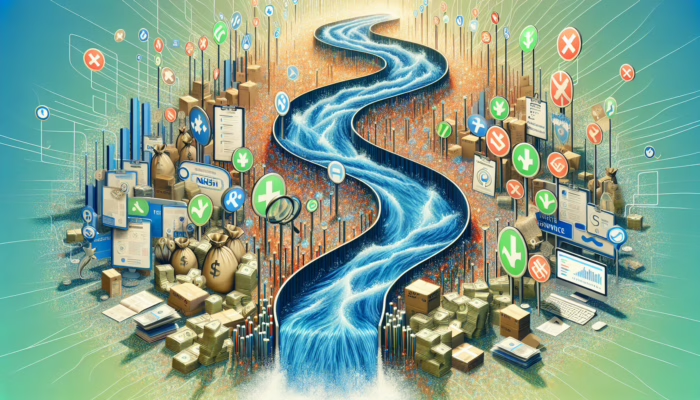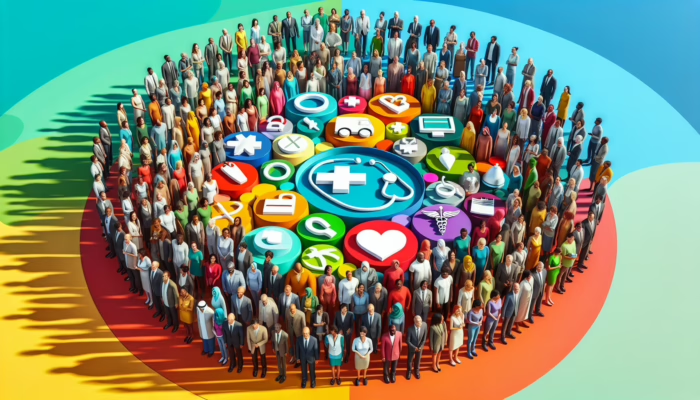Comprehending the Complexities of the UK Healthcare Market
The UK healthcare market is an intricate and ever-changing landscape, presenting abundant opportunities for those eager to expand your healthcare business sustainably. With a growing ageing population, a rise in chronic health conditions, and shifting patient expectations, gaining a profound understanding of this market is critical for any healthcare provider aiming for success. By staying informed about the dynamics of patient needs and industry trends, providers can better position themselves to meet the challenges of tomorrow while ensuring their services remain relevant and effective.
Thorough Market Analysis for Informed Decision-Making

The UK healthcare sector, largely supported by the National Health Service (NHS), is characterised by a unique combination of public and private services. To navigate this complex landscape effectively, conducting comprehensive market research is essential. Recent studies indicate a rising demand for services tailored specifically for chronic disease management and mental health support, reflecting a significant shift in patient needs. For instance, the increasing prevalence of lifestyle-related diseases such as diabetes and obesity presents a substantial opportunity for healthcare businesses to introduce preventive care and wellness programmes that address these growing concerns.
In addition to chronic care, there is an escalating focus on personalised medicine and patient-centred approaches. Providers who can utilise data analytics and actively seek patient feedback to deliver tailored treatment options are likely to experience enhanced patient satisfaction and loyalty. Moreover, the incorporation of technology in healthcare—ranging from telehealth services to AI-driven diagnostics—is revolutionising the delivery of care, making it imperative for businesses to remain ahead of technological advancements and adapt accordingly.
Market trends also indicate a growing consumer preference for sustainability within healthcare practices. Patients are increasingly selecting providers based on their environmental impact and dedication to eco-friendly operations. This trend urges healthcare businesses to adopt sustainable practices—not only to comply with regulations but also to solidify their brand identity as responsible and forward-thinking organisations.
Ultimately, a comprehensive understanding of the UK healthcare market necessitates a holistic perspective that encompasses patient needs, regulatory frameworks, and emerging trends. By aligning business strategies with these insights, healthcare providers can effectively position themselves for sustainable growth and long-term success in this dynamic industry.
Navigating the Complex Regulatory Environment of UK Healthcare
Successfully navigating the intricate regulatory landscape of the UK healthcare system is an essential undertaking for any healthcare business aiming to expand sustainably. The healthcare sector in the UK operates under rigorous regulatory frameworks, primarily overseen by the Care Quality Commission (CQC) and the General Medical Council (GMC). These bodies establish stringent standards for safety, quality, and accountability, making it imperative for providers to thoroughly understand and comply with these regulations to avoid potential pitfalls.
Compliance not only safeguards patients but also bolsters the credibility of your healthcare business. For instance, maintaining meticulous records, ensuring data protection in accordance with the General Data Protection Regulation (GDPR), and adhering to rigorous health and safety standards are all vital components of regulatory compliance. Healthcare businesses that neglect these requirements risk facing penalties, reputational harm, and ultimately, a loss of patient trust.
Furthermore, recent changes in healthcare policy, particularly surrounding integrated care systems, underscore the necessity for collaboration amongst various health and social care providers. Such partnerships can enhance the delivery of services and improve health outcomes, creating a more cohesive and supportive care pathway for patients.
Beyond compliance, integrating ethical considerations into your business model is becoming increasingly crucial. Patients are more aware of their rights and the ethical implications surrounding their healthcare choices. By prioritising transparency and ethical practices, healthcare businesses can cultivate trust and loyalty, which are vital for long-term success in a competitive market.
In summary, a robust understanding of the regulatory environment is a cornerstone of expanding your healthcare business sustainably, ensuring that patient safety, ethical considerations, and compliance are at the forefront of your operations.
Identifying and Addressing Consumer Needs in Healthcare
Understanding the unique healthcare needs and preferences of UK patients is essential for effectively tailoring services. As the demographic landscape shifts—with an ageing population and increasing diversity—the healthcare sector must evolve to meet the various demands of its patients. This adaptation is crucial for ensuring that healthcare providers remain relevant and effective in a competitive environment.
Recent studies reveal that UK patients are increasingly prioritising convenience and accessibility in their healthcare services. This shift has driven a surge in demand for on-demand services, such as online consultations and home-based care. Healthcare businesses that can offer flexible appointment options and remote monitoring solutions are well-positioned to gain a competitive advantage in this evolving market.
In addition to convenience, there is a growing expectation for personalised care. Patients desire to be treated as individuals rather than simply as diagnoses or conditions. This necessitates a more holistic approach to healthcare, where mental and emotional wellbeing are considered alongside physical health. Implementing patient feedback mechanisms can greatly assist healthcare providers in understanding and responding to patient preferences, thereby enhancing overall satisfaction and loyalty.
Moreover, cultural competence is becoming increasingly vital in the UK’s multicultural society. Healthcare businesses must acknowledge and respect cultural differences in health beliefs and practices. By providing culturally sensitive care and actively engaging with diverse communities, businesses can improve health outcomes while simultaneously building lasting relationships with patients.
Ultimately, understanding and addressing consumer needs is critical for any healthcare provider seeking to expand sustainably. By emphasising patient-centred care, flexibility, and cultural competence, healthcare businesses can ensure their services remain relevant and trusted in an ever-competitive landscape.
Creating a Sustainable Business Model for Healthcare Success

Developing a sustainable business model is imperative for healthcare providers aiming to flourish in the UK market. As the sector continues to evolve, the integration of eco-friendly practices, financial viability, and community engagement becomes essential in expanding your healthcare business sustainably. This approach not only benefits the environment but also enhances the long-term success of healthcare organisations.
Implementing Eco-friendly Practices in Healthcare
As global environmental concerns escalate, the UK healthcare sector is increasingly scrutinised for its carbon footprint. Implementing eco-friendly practices is no longer merely a choice but an essential requirement for sustainable growth. Healthcare providers can adopt strategies that include reducing waste, utilising renewable energy sources, and promoting telehealth services to limit travel-related emissions, thus contributing to a more sustainable healthcare system.
Recycling and the proper disposal of medical waste are critical components of an eco-friendly healthcare practice. By collaborating with organisations that specialise in sustainable waste management, businesses can ensure compliance with environmental regulations while also contributing to a greener planet. Moreover, transitioning to digital records reduces reliance on paper, further decreasing waste while enhancing operational efficiency.
Additionally, incorporating green building practices can significantly reduce a healthcare facility’s environmental impact. Implementing energy-efficient lighting, using sustainable building materials, and adopting water conservation measures not only lowers operational costs but also attracts environmentally-conscious patients who value sustainability in their healthcare choices.
Healthcare providers should also consider community wellness initiatives that promote environmental sustainability. For instance, organising health fairs that focus on preventive care while incorporating eco-friendly practices can enhance community engagement and demonstrate a commitment to sustainability in healthcare delivery.
Ultimately, integrating eco-friendly practices into healthcare operations is a powerful strategy for fostering a sustainable business model that resonates with both patients and the wider community, ensuring a healthier future for all.
Ensuring Financial Sustainability in Healthcare
Developing a robust financial plan is fundamental to ensuring long-term viability and growth within the UK healthcare market. As healthcare costs continue to rise, creating strategies that enhance financial sustainability is paramount for providers seeking to expand their services and build resilient operations.
One effective approach is to diversify revenue streams. By offering a variety of services, such as private consultations, wellness programmes, and specialised care, healthcare businesses can reduce financial risks associated with reliance on a single source of income. Additionally, exploring collaborations with insurance companies for value-based care models can further improve financial stability and sustainability.
Investing in technology can yield significant returns over time. Implementing electronic health records (EHR) and efficient data management systems not only enhances operational efficiency but also reduces administrative costs. Furthermore, telemedicine services can lower overhead while expanding patient reach, enabling businesses to thrive in a competitive environment.
Monitoring financial performance through regular audits and key performance indicators (KPIs) is essential for informed decision-making. Understanding aspects such as cash flow, patient acquisition costs, and service profitability can help healthcare providers identify areas needing improvement and optimise resource allocation effectively.
Ultimately, a well-structured financial plan that anticipates market fluctuations and embraces innovation is crucial for healthcare businesses seeking to expand sustainably in the UK. By prioritising financial health, providers can ensure their operations remain viable and prepared for future challenges.
Fostering Community Engagement for Healthcare Success

Engaging with local communities is a cornerstone of building a sustainable healthcare business in the UK. Establishing strong relationships within the community not only enhances trust but also fosters a supportive environment for your services, ultimately leading to improved health outcomes.
One effective strategy is to participate in local health initiatives and outreach programmes. These engagements can take various forms, from free health screenings to educational workshops that address prevalent health issues within the community. Such efforts demonstrate a genuine commitment to community wellbeing and can significantly increase visibility and trust in your healthcare services.
Moreover, collaborating with local organisations and charities can amplify your impact within the community. For example, partnering with mental health charities to offer workshops or support groups can directly address pressing community needs while positioning your healthcare business as a leader in holistic care.
Encouraging community feedback through surveys and open forums is another effective way to engage. Understanding the unique needs of the local population can guide service offerings, ensuring they resonate with community preferences and effectively meet healthcare demands.
Investing in community engagement not only enhances your brand reputation but also strengthens patient loyalty. When patients feel valued and understood, they are more likely to return and recommend your services to others, fostering organic growth and ensuring long-term sustainability.
In summary, prioritising community engagement is essential for healthcare providers aiming to expand sustainably. By actively participating in local initiatives and understanding community needs, businesses can build lasting relationships that benefit both the provider and the population as a whole.
Harnessing Technology for Sustainable Growth in Healthcare
In a rapidly evolving healthcare landscape, leveraging technology is a powerful strategy for growth. As providers seek to expand your healthcare business sustainably, integrating digital health solutions, telemedicine, and data management systems becomes increasingly essential for enhancing patient care and operational efficiency.
Enhancing Patient Care Through Digital Health Solutions
The rise of digital health solutions has fundamentally transformed patient care, offering innovative ways to enhance services and streamline operations. Embracing these technologies allows healthcare businesses to improve patient engagement and satisfaction while optimising resource allocation. By leveraging digital tools, providers can enhance their overall service delivery and ensure patients receive timely and effective care.
Digital platforms enable instant communication between healthcare providers and patients, thereby enhancing the overall patient experience. For instance, patient portals allow individuals to access their health information, schedule appointments, and communicate with their care team conveniently. This level of accessibility fosters a sense of empowerment among patients, encouraging them to take an active role in their health journey.
Moreover, integrating wearable health technology can provide valuable data for providers. Devices that track vital signs, physical activity, and other health metrics facilitate remote patient monitoring, allowing for timely interventions and personalised care. This proactive approach not only improves health outcomes but also reduces the burden on healthcare facilities, enabling them to allocate resources more efficiently.
Additionally, incorporating artificial intelligence (AI) into healthcare workflows can streamline administrative tasks, enhance diagnostics, and predict patient outcomes. By leveraging AI analytics, healthcare providers can identify trends and make data-driven decisions that improve operational efficiency and patient care. This technology-driven approach enables providers to stay competitive in an ever-changing healthcare landscape.
Ultimately, the adoption of digital health solutions is crucial for healthcare businesses looking to expand sustainably. By embracing technology, providers can enhance patient care, improve efficiency, and remain competitive in an increasingly digital world.
Expanding Access Through Telemedicine Services
Telemedicine has emerged as a vital component of modern healthcare, especially in the wake of recent global events that necessitated greater accessibility. Offering telemedicine services enables healthcare providers to reach more patients across the UK while improving accessibility and convenience in care delivery.
Patients increasingly demand the ability to receive care from the comfort of their homes. Telemedicine provides a solution to this need, offering consultations via video calls or secure messaging. This approach eliminates geographical barriers, making it especially beneficial for patients in rural areas or those with mobility issues, thereby enhancing health equity.
Furthermore, telemedicine can enhance continuity of care, enabling healthcare providers to maintain regular contact with patients without the need for in-person visits. This is particularly valuable for managing chronic conditions, where ongoing monitoring and support are essential for effective treatment and improved health outcomes.
Implementing telemedicine services requires adherence to regulatory standards, including data protection laws. Ensuring compliance not only safeguards patient information but also builds trust in your telehealth offerings, encouraging more patients to take advantage of these services.
Additionally, promoting your telemedicine services through targeted marketing campaigns can enhance visibility and attract new patients. Highlighting the convenience, accessibility, and efficiency of virtual care can resonate with prospective patients seeking modern healthcare solutions that fit their lifestyles.
In summary, integrating telemedicine services into your healthcare offerings is a key strategy for expanding sustainably. By embracing this technology, providers can enhance patient access, improve care continuity, and position themselves as forward-thinking leaders in the healthcare space.
Optimising Operations with Data Management Systems
Efficient data management systems are essential for healthcare providers in the UK to comply with regulations and ensure optimal patient care. Implementing robust data management solutions not only enhances operational efficiency but also safeguards sensitive patient information, which is critical in maintaining trust and compliance with legal standards.
The integration of electronic health records (EHR) has revolutionised healthcare data management. Transitioning from paper-based records to EHR systems allows for seamless access to patient information, reducing the likelihood of errors and improving care coordination. This is particularly crucial in the UK, where multiple healthcare professionals often collaborate on patient care, necessitating accurate and timely information sharing.
Compliance with the General Data Protection Regulation (GDPR) is paramount in managing patient data effectively. Healthcare businesses must establish stringent protocols for data security, including encryption, regular audits, and staff training. By prioritising data protection, providers can ensure patient trust and mitigate the risk of data breaches, which can have serious legal and financial repercussions.
Moreover, leveraging data analytics can provide valuable insights into patient populations, treatment outcomes, and operational performance. By analysing trends and identifying areas for improvement, healthcare providers can enhance their services and increase patient satisfaction, ultimately leading to better health outcomes.
Ultimately, adopting efficient data management systems is vital for healthcare businesses seeking to expand sustainably. By ensuring compliance, optimising care coordination, and harnessing the power of data analytics, providers can position themselves for success in an increasingly data-driven healthcare landscape.
Enhancing Care with Electronic Health Records
The adoption of electronic health records (EHR) is a pivotal step for healthcare providers aiming to improve patient care and operational efficiency. EHR systems facilitate better data sharing, enhance care coordination, and ultimately contribute to the sustainability of healthcare businesses in the UK by providing a comprehensive view of patient medical histories.
EHRs offer healthcare professionals quick access to a patient’s medical history, enabling informed decision-making in a timely manner. This accessibility is particularly crucial in emergency situations, where rapid access to a patient’s data can significantly impact outcomes. Moreover, EHRs enhance communication between different care providers, ensuring a more integrated approach to patient health that improves overall care quality.
Implementing EHR systems also streamlines administrative tasks, reducing paperwork and freeing up valuable time for healthcare professionals to focus on patient care. This efficiency not only enhances the patient experience but can also lead to cost savings for healthcare facilities, allowing them to allocate resources more effectively.
Additionally, EHRs enable healthcare providers to leverage data analytics to identify trends and assess treatment efficacy. By analysing aggregated patient data, businesses can develop targeted interventions and improve population health management, enhancing their overall impact on community health.
However, the successful implementation of EHR systems requires careful planning and adherence to regulatory standards. Providers must ensure that their systems are secure, user-friendly, and compliant with NHS Digital guidelines to protect patient information and maintain trust.
In summary, embracing electronic health records is a foundational element of expanding your healthcare business sustainably. By enhancing data accessibility, improving care coordination, and enabling data-driven decision-making, EHRs contribute to a more efficient and effective healthcare delivery system that benefits both providers and patients.
Utilising AI and Machine Learning for Healthcare Innovation
The integration of artificial intelligence (AI) and machine learning into healthcare operations presents transformative opportunities for providers in the UK. As the demand for personalised care and efficient services grows, leveraging these technologies is essential for expanding your healthcare business sustainably.
AI can enhance clinical decision-making by analysing vast amounts of patient data to identify patterns that human providers may overlook. For example, AI algorithms can predict patient outcomes based on historical data, allowing healthcare professionals to tailor treatment plans more effectively. This predictive capability not only improves patient care but also optimises resource allocation within healthcare facilities, leading to more efficient and effective service delivery.
Moreover, machine learning can streamline administrative processes, from appointment scheduling to billing. Automating routine tasks reduces the administrative burden on staff, enabling them to focus more on patient care and enhancing overall productivity. This increased efficiency can translate into better patient experiences and outcomes.
Integrating AI into diagnostic processes can also lead to faster and more accurate results. For instance, AI-driven imaging analysis can assist radiologists in identifying abnormalities in scans, thereby improving diagnostic accuracy and reducing waiting times for patients.
However, the implementation of AI and machine learning requires careful consideration of ethical implications and data privacy concerns. Ensuring compliance with regulatory standards, such as GDPR, is essential to protect patient information while harnessing the power of these transformative technologies.
In conclusion, incorporating AI and machine learning is pivotal for healthcare providers seeking to expand sustainably. By enhancing decision-making, streamlining operations, and improving diagnostic accuracy, these technologies enable healthcare businesses to thrive in a competitive landscape, ultimately benefiting patients and the healthcare system as a whole.
Building a Strong and Resilient Workforce in Healthcare
A strong workforce is the backbone of any successful healthcare business. For providers looking to expand your healthcare business sustainably, it is essential to develop effective recruitment strategies, prioritise ongoing training, and support employee wellbeing. A motivated and skilled workforce is vital for delivering exceptional patient care and ensuring the long-term success of healthcare organisations.
Effective Recruitment Strategies to Attract Top Talent
Attracting skilled healthcare professionals is a fundamental requirement for sustainable growth in the healthcare sector. The UK faces a notable skills shortage in various healthcare fields, making it essential to develop targeted recruitment strategies to secure top talent who align with your organisational values and goals.
One effective approach is to collaborate with educational institutions, such as universities and nursing colleges, to create internship and training programmes. These partnerships can provide students with real-world experience while allowing healthcare providers to identify potential recruits early in their careers, fostering a pipeline of skilled professionals ready to enter the workforce.
Moreover, leveraging social media and online job platforms to promote job openings can widen your reach and attract a diverse pool of candidates. Highlighting your organisation’s commitment to sustainability, employee development, and a positive work environment can appeal to candidates who share your values and seek meaningful employment.
Offering competitive compensation packages is also crucial in attracting top talent. Beyond salary, consider additional benefits such as flexible working hours, professional development opportunities, and wellness programmes. These incentives can make your healthcare business a more attractive option for potential employees, increasing the likelihood of securing skilled professionals.
Furthermore, fostering a diverse and inclusive workplace can enhance your recruitment efforts. A workforce that reflects the diverse UK population can improve patient communication and outcomes, making your services more accessible and relatable to a wider range of patients.
Overall, implementing strategic recruitment initiatives is essential for healthcare providers aiming to expand sustainably. By focusing on attracting, cultivating, and retaining top talent, businesses can build a robust workforce capable of delivering exceptional patient care while navigating the challenges of the healthcare landscape.
Investing in Continuous Training and Development
Investing in continuous training and development programmes is crucial for maintaining a skilled and motivated healthcare workforce. As the healthcare landscape evolves, ongoing education ensures that staff remain updated on best practices, emerging technologies, and regulatory changes, enhancing the quality of care provided to patients.
One effective strategy is to implement regular training sessions and workshops that cover a range of topics, including clinical skills, patient communication, and cultural competence. By providing opportunities for professional growth, healthcare providers empower their employees to excel in their roles and deliver high-quality care that meets the needs of diverse patient populations.
Mentorship programmes can also play a significant role in staff development. Pairing experienced healthcare professionals with newer team members fosters knowledge sharing and creates a supportive environment. This not only enhances clinical skills but also nurtures a culture of collaboration and mutual respect within the organisation.
Furthermore, investing in leadership development initiatives prepares future leaders within your organisation. Developing managerial and leadership skills among staff can result in improved team dynamics and better patient care outcomes, ensuring a strong foundation for the future of your healthcare business.
Finally, encouraging employees to pursue further education, such as certifications or advanced degrees, demonstrates a commitment to their growth and success. Offering financial support or flexible working arrangements can incentivise staff to invest in their professional development, creating a more knowledgeable and skilled workforce.
In summary, prioritising training and development is essential for healthcare providers seeking to expand sustainably. By fostering a culture of continuous learning, businesses can enhance staff capabilities, improve patient care, and position themselves for long-term success in the healthcare sector.
Supporting Employee Wellbeing for Optimal Performance
The wellbeing of healthcare workers is a critical factor in maintaining a healthy and productive workforce. Prioritising employee wellbeing not only enhances job satisfaction but also translates into better patient care, making it a vital component of any sustainable healthcare business model.
Creating a supportive work environment involves recognising the challenges faced by healthcare professionals, particularly in high-stress situations. Implementing wellness programmes that offer mental health support, stress management resources, and work-life balance initiatives can significantly contribute to employee satisfaction and retention.
Encouraging open communication and feedback allows staff to voice their concerns and suggestions. By fostering a culture of transparency, healthcare providers can identify areas for improvement and make necessary adjustments to enhance the work environment, promoting a sense of belonging and value among employees.
Offering flexible working arrangements, such as remote work options or adjusted schedules, can help employees manage their personal and professional lives more effectively. This flexibility can lead to reduced burnout and increased job satisfaction, which ultimately benefits both staff and patients.
Moreover, recognising and rewarding staff contributions can bolster morale. Implementing recognition programmes that celebrate achievements—whether big or small—creates a positive work atmosphere and reinforces a sense of belonging within the organisation.
Ultimately, prioritising employee wellbeing is essential for healthcare providers looking to expand sustainably. A motivated and healthy workforce not only enhances patient care but also contributes to the long-term success of the organisation by fostering a positive and productive work environment.
Expanding Service Offerings for Comprehensive Care
In an ever-evolving healthcare landscape, expanding service offerings is a key strategy for providers looking to thrive. By introducing new specialisations, developing integrated care models, and launching preventive health programmes, healthcare businesses can expand your healthcare business sustainably, ultimately improving patient outcomes and satisfaction.
Introducing New Specialisations to Meet Patient Needs
Exploring opportunities to introduce new healthcare specialisations is essential for meeting the diverse needs of UK patients. As healthcare demands evolve, providers must adapt their services to address emerging health trends and patient preferences, ensuring they remain relevant and competitive in the market.
For example, the increasing prevalence of mental health issues has prompted a growing demand for specialised mental health services. Providers who can offer tailored mental health programmes—including therapy, counselling, and support groups—can significantly enhance their service portfolio and attract a broader patient base seeking comprehensive care.
Moreover, the rise in chronic health conditions such as diabetes and cardiovascular diseases necessitates the introduction of specialised care programmes. Providing services that focus on disease management, education, and lifestyle interventions can position healthcare businesses as leaders in comprehensive and effective care delivery.
Additionally, the growing interest in complementary and alternative medicine presents an opportunity for providers to explore new service lines. By incorporating holistic approaches, such as acupuncture, physiotherapy, or nutritional counselling, healthcare businesses can cater to patients seeking a more integrative approach to their health and wellbeing.
Ultimately, expanding service offerings to include new specialisations is critical for healthcare providers aiming to expand sustainably. By addressing emerging healthcare needs, businesses can enhance patient satisfaction, improve overall health outcomes, and solidify their position in the healthcare market.
Developing Integrated Care Models for Enhanced Patient Experiences
Creating integrated care models is a strategic approach to enhancing patient outcomes and experiences. In a fragmented healthcare system, integrating services can provide a more cohesive care pathway for patients, leading to improved health results and greater patient satisfaction.
Integrated care involves coordinated efforts between various healthcare providers, including primary care, specialists, and social services. This collaborative approach ensures that patients receive comprehensive care that addresses their physical, mental, and social needs, ultimately leading to better health outcomes.
For instance, implementing multidisciplinary teams that collaborate on patient care can result in more effective treatment plans and improved communication among providers. This collaborative model enhances continuity of care, ensuring that patients feel supported throughout their healthcare journey and reducing the risk of fragmented care.
Moreover, adopting technology, such as shared electronic health records, facilitates seamless communication and data sharing among providers. This integration allows for a holistic view of patient health, enabling tailored interventions and reducing the risk of duplicative tests or procedures, ultimately enhancing the efficiency of healthcare delivery.
Additionally, integrated care models can improve patient engagement and satisfaction. When patients receive coordinated care that considers their unique needs and preferences, they are more likely to adhere to treatment plans and actively participate in their health management, leading to better health outcomes.
In summary, developing integrated care models is essential for healthcare providers looking to expand sustainably. By fostering collaboration and coordination among healthcare professionals, businesses can enhance patient outcomes and create a more efficient healthcare system that prioritises patient-centred care.
Launching Preventive Health Programmes for Long-term Wellness
Launching preventive health programmes is a proactive strategy for promoting wellness and reducing healthcare costs in the UK. By focusing on prevention rather than treatment, healthcare providers can improve population health and enhance their service offerings, ultimately leading to healthier communities.
Preventive health programmes can encompass a wide range of initiatives, including health screenings, immunisation campaigns, and wellness education. By providing these services, healthcare businesses can help patients identify potential health issues early on, facilitating timely interventions that can prevent the progression of diseases and reduce the burden on healthcare systems.
For example, implementing community health fairs that offer free screenings for conditions like hypertension and diabetes can significantly raise awareness and encourage individuals to take charge of their health. These initiatives not only engage the community but also position your healthcare business as a leader in preventive care, fostering trust and loyalty among patients.
Additionally, offering educational workshops on nutrition, physical activity, and stress management can empower patients to make healthier lifestyle choices. By equipping individuals with the knowledge and tools they need to maintain their health, healthcare providers can foster a culture of wellness within the community and promote long-term health.
Moreover, collaborating with local businesses and organisations to promote wellness initiatives can further enhance the reach of preventive programmes. By working together, healthcare providers can amplify their impact and create a comprehensive approach to community health that addresses the specific needs of the population.
Ultimately, launching preventive health programmes is vital for healthcare providers seeking to expand sustainably. By prioritising prevention, businesses can enhance health outcomes, reduce healthcare costs, and improve overall community wellbeing, creating a healthier future for all.
Effective Marketing and Branding Strategies in the UK Healthcare Sector
Establishing a strong marketing and branding strategy is pivotal for healthcare providers aiming to thrive in the UK market. By creating targeted marketing campaigns, managing brand reputation, and leveraging patient testimonials, businesses can effectively expand your healthcare business sustainably while building trust and credibility within the community.
Creating Targeted Marketing Campaigns for Healthcare Consumers
Developing targeted marketing campaigns is essential for effectively reaching and engaging with UK healthcare consumers. As competition increases, healthcare providers must devise strategies that resonate with specific patient populations, ensuring that their messaging is relevant and impactful.
Understanding your target audience is the first step in creating effective marketing campaigns. Conducting market research to identify patient demographics, preferences, and healthcare needs can inform your messaging and promotional strategies. For instance, younger patients may respond better to social media marketing, while older demographics might prefer traditional marketing methods such as print advertising.
Additionally, utilising digital marketing tools, such as search engine optimisation (SEO) and pay-per-click advertising, can significantly enhance your online visibility. By optimising your website for relevant keywords, healthcare providers can attract more traffic and increase patient inquiries, ultimately driving growth.
Engaging content is also crucial for successful marketing campaigns. Creating informative blog posts, videos, and infographics that address common health concerns can position your healthcare business as a trusted resource. This approach not only educates patients but also builds credibility and trust in your brand, encouraging patient loyalty.
Furthermore, leveraging social media platforms to share success stories, health tips, and community events can foster engagement and create a sense of community among patients. This active online presence can significantly enhance your brand’s visibility and reputation, attracting new patients to your services.
Ultimately, developing targeted marketing campaigns is vital for healthcare providers seeking to expand sustainably. By understanding and addressing the needs of your audience, businesses can effectively engage with patients and enhance their market presence, leading to long-term success.
Managing Brand Reputation for Trust and Credibility
Managing your brand’s reputation is crucial for building trust and credibility within the UK healthcare market. In an industry where patient trust is paramount, proactive reputation management can significantly impact your success and foster lasting relationships with patients.
Monitoring online reviews and patient feedback is essential for understanding public perception. Actively engaging with patients who leave reviews—both positive and negative—demonstrates that you value their opinions and are committed to improving your services. Responding to feedback transparently and promptly can turn negative experiences into opportunities for growth and improvement.
Moreover, highlighting your commitment to patient safety and quality care through accreditation and awards can enhance your brand’s reputation. Certifications from recognised bodies, such as the Care Quality Commission (CQC), serve as powerful endorsements of your commitment to excellence, reassuring patients of the quality of care they can expect.
Additionally, utilising patient testimonials can be a potent tool for reputation management. Showcasing success stories on your website and marketing materials can provide potential patients with confidence in your services. By sharing real experiences, healthcare providers can create emotional connections with prospective patients, enhancing brand loyalty and trust.
Furthermore, participating in community initiatives and health fairs can enhance your brand’s visibility and reputation. By demonstrating a commitment to community wellbeing, healthcare providers can foster goodwill and strengthen their brand identity, making them more relatable and trusted by patients.
In conclusion, effective brand reputation management is essential for healthcare providers looking to expand sustainably. By actively monitoring feedback, highlighting achievements, and engaging with patients, businesses can build a trusted and credible healthcare brand that stands out in a competitive market.
Leveraging Patient Testimonials for Trust Building
Utilising patient testimonials is a powerful strategy for showcasing the quality and impact of your healthcare services. In an industry where personal experiences greatly influence decisions, positive testimonials can significantly enhance your reputation and attract new patients to your practice.
Encouraging satisfied patients to share their stories can create authentic content that resonates with prospective patients. Testimonials provide valuable insights into the patient experience, highlighting the compassionate care and positive outcomes that your healthcare business delivers, ultimately reinforcing trust in your services.
Incorporating patient testimonials into your marketing materials—such as brochures, websites, and social media—can enhance your credibility. Displaying real experiences can foster trust among potential patients, encouraging them to choose your services over competitors, which is vital in a crowded marketplace.
Moreover, creating case studies that detail specific patient journeys can offer a more in-depth narrative. These stories can illustrate the comprehensive care your business provides, showcasing the effectiveness of treatments and the positive impacts on patients’ lives, thus enhancing your brand’s appeal.
Additionally, using video testimonials can further amplify the impact of patient stories. Visual content is often more engaging and can create a stronger emotional connection. Sharing video testimonials on social media or your website can enhance visibility and reach a broader audience, making your services more relatable and trustworthy.
Ultimately, leveraging patient testimonials is essential for healthcare providers seeking to expand sustainably. By showcasing authentic patient experiences, businesses can build trust, enhance their brand reputation, and attract new patients, ensuring long-term success in the healthcare sector.
Implementing Effective Digital Marketing Strategies
Implementing effective digital marketing strategies is critical for enhancing your brand’s visibility and engagement with UK healthcare consumers. In a digital age, establishing a strong online presence is essential for any healthcare provider aiming to expand sustainably and connect with patients in meaningful ways.
Search engine optimisation (SEO) is a cornerstone of digital marketing. By optimising your website for relevant keywords and creating high-quality content, healthcare providers can improve their search rankings and attract organic traffic. This process involves researching common patient queries and addressing them through informative blog posts and resource pages that offer valuable insights.
Moreover, utilising social media platforms allows for direct engagement with patients. Sharing valuable health tips, updates on services, and community involvement can foster a sense of connection with your audience. Active social media engagement can enhance brand loyalty and encourage patient referrals, ultimately driving growth and success.
Additionally, email marketing is a powerful tool for maintaining communication with patients. Sending regular newsletters with health information, updates on services, and patient success stories can keep your audience engaged and informed. This approach reinforces your commitment to patient care and positions your brand as a trusted resource for health-related information.
Furthermore, investing in pay-per-click (PPC) advertising can enhance visibility and attract new patients. Targeted ads can reach specific demographics, ensuring that your marketing efforts resonate with the right audience and drive meaningful engagement.
In summary, implementing effective digital marketing strategies is crucial for healthcare providers looking to expand sustainably. By optimising online presence, engaging with patients, and utilising various digital channels, businesses can enhance visibility, attract new patients, and solidify their position in the competitive healthcare market.
Establishing Partnerships and Collaborations for Enhanced Service Delivery
Forming partnerships and collaborations is a powerful strategy for healthcare providers seeking to enhance their service delivery and expand sustainably. By leveraging the strengths of other organisations, healthcare businesses can create a more comprehensive approach to patient care that improves outcomes and enhances overall community health.
Building Strategic Alliances with Healthcare Providers
Establishing strategic alliances with other UK healthcare providers is essential for expanding your service network. Collaborative efforts can enhance patient care and create a more integrated healthcare system that benefits both providers and patients alike.
For instance, partnering with local hospitals, clinics, or specialist providers allows for seamless referrals and coordinated care. This collaboration ensures that patients receive appropriate treatments and follow-ups, ultimately improving health outcomes and patient satisfaction.
Moreover, strategic alliances can facilitate resource sharing, reducing costs and enhancing service efficiency. By pooling resources with other providers, healthcare businesses can invest in advanced technologies and services that may otherwise be unaffordable, thus improving the quality of care delivered to patients.
Additionally, partnerships with community organisations can enhance outreach efforts and improve access to care for underserved populations. Collaborating with charities or local health initiatives allows healthcare providers to engage with the community directly, addressing specific health needs and concerns while promoting health equity.
Furthermore, exploring partnerships with academic institutions can drive research and innovation in healthcare. Collaborating on research projects can enhance clinical practices and contribute to advancements in medical knowledge, ultimately benefiting the healthcare sector as a whole.
In conclusion, forming strategic alliances is vital for healthcare providers looking to expand sustainably. By collaborating with other organisations, businesses can enhance patient care, optimise resources, and strengthen their market position, ensuring long-term success in a competitive landscape.
Engaging in Research Collaborations for Innovation
Engaging in research collaborations with UK institutions is a key strategy for advancing healthcare innovation and services. Collaborative research efforts can lead to breakthroughs in treatments, technology, and patient care practices, ultimately enhancing the quality of healthcare delivery.
Partnering with universities and research organisations allows healthcare providers to access cutting-edge research and expertise. These collaborations can facilitate clinical trials, improving patient access to novel therapies while contributing to the advancement of medical knowledge and the healthcare field.
Moreover, participating in research initiatives can enhance the reputation of healthcare providers. By being involved in significant studies, businesses position themselves as leaders in their field, attracting both patients and top talent who seek to align with innovative and progressive healthcare organisations.
Additionally, research collaborations can drive the development of evidence-based practices. By integrating research findings into clinical protocols, healthcare providers can enhance the quality of care and improve patient outcomes, ultimately benefiting the populations they serve.
Furthermore, collaborating on public health research initiatives can address pressing community health issues. By investigating local health trends and needs, healthcare providers can develop targeted interventions that resonate with the populations they serve, ultimately improving health outcomes and community wellbeing.
Ultimately, engaging in research collaborations is essential for healthcare providers seeking to expand sustainably. By fostering innovation and contributing to medical advancements, businesses can enhance their service offerings and improve patient care, ensuring they remain at the forefront of the healthcare sector.
Forging Community Partnerships for Local Impact
Developing partnerships with UK community organisations is a strategic approach to enhancing your social impact and reach. Collaborating with local groups allows healthcare providers to engage directly with the communities they serve, ultimately improving health outcomes and access to care.
Community partnerships can take various forms, such as joint health initiatives, educational programmes, or wellness events. For example, partnering with local schools to provide health education workshops can empower young people with essential knowledge about healthy lifestyles, fostering a culture of health within the community.
Moreover, collaborating with charities and non-profit organisations can improve access to care for vulnerable populations. By working together on outreach programmes, healthcare providers can address social determinants of health and promote equity in healthcare access, ensuring that all individuals have the opportunity to receive quality care.
Engaging with community organisations also allows healthcare providers to gain valuable insights into local health needs. Understanding community concerns and preferences can inform service development, ensuring that offerings resonate with the population and effectively meet healthcare demands.
Additionally, community partnerships can enhance brand visibility and goodwill. By actively participating in local initiatives, healthcare providers can demonstrate their commitment to community wellbeing, fostering trust and loyalty among patients and improving overall community health.
In summary, developing community partnerships is essential for healthcare providers looking to expand sustainably. By collaborating with local organisations, businesses can enhance their social impact, improve access to care, and strengthen community relationships that benefit both providers and the populations they serve.
Collaborating with Industry Leaders for Resource Sharing
Forging partnerships with UK industry leaders is a strategic approach to leveraging technology and resources for healthcare improvements. Collaborating with established firms can enhance service delivery and drive innovation in healthcare practices, ultimately benefiting both providers and patients.
For example, partnering with technology companies can facilitate the integration of advanced healthcare solutions, such as telemedicine platforms or data analysis tools. These collaborations can enhance the efficiency and effectiveness of healthcare services, ultimately benefiting patients through improved access and care delivery.
Moreover, industry partnerships can provide access to specialised training and expertise. Collaborating with companies experienced in healthcare technology can empower staff with the knowledge and skills necessary to utilise new tools effectively, enhancing the quality of care provided to patients.
Additionally, exploring partnerships with pharmaceutical companies can enhance access to innovative treatments and clinical trials. Collaborating on research and development initiatives can lead to advances in patient care and improve treatment options for specific health conditions, ultimately benefiting the healthcare system as a whole.
Furthermore, engaging with industry leaders can open avenues for funding and resource sharing. By pooling resources with established firms, healthcare providers can invest in technology and services that enhance patient care without compromising financial sustainability.
In conclusion, forming industry partnerships is vital for healthcare providers seeking to expand sustainably. By leveraging the strengths of established firms, businesses can enhance their service offerings and drive innovation in healthcare, ultimately improving health outcomes for patients and communities.
Engaging in International Collaborations for Knowledge Exchange
Establishing collaborations with global healthcare entities is an invaluable strategy for sharing knowledge and enhancing service delivery. International partnerships can foster innovation and improve patient care practices through the exchange of ideas and best practices from around the world.
Collaborating with foreign healthcare organisations allows providers to access diverse perspectives on patient care and management. This exposure can inspire new approaches to treatment and care delivery, ultimately benefiting patients and enhancing the quality of care provided.
Moreover, participating in global health initiatives can enhance the reputation of healthcare providers. Being involved in international research or health campaigns positions businesses as leaders in their field, attracting interest from both patients and professionals seeking to collaborate with innovative organisations.
Additionally, international collaborations can facilitate knowledge transfer, enabling healthcare providers to learn from successful programmes implemented elsewhere. Adopting evidence-based practices from other countries can lead to improvements in patient outcomes and service efficiency, ultimately benefiting the healthcare system as a whole.
Furthermore, engaging in international partnerships can enhance workforce development. Collaborating with foreign institutions can provide staff with opportunities for professional development, expanding their skills and knowledge and ultimately contributing to a more competent healthcare workforce.
Ultimately, engaging in international collaborations is essential for healthcare providers seeking to expand sustainably. By fostering global connections, businesses can enhance service delivery, drive innovation, and improve patient care, ensuring they remain at the forefront of the healthcare sector.
Frequently Asked Questions (FAQs)
What does it mean to expand a healthcare business sustainably?
Expanding a healthcare business sustainably means growing operations while considering environmental, social, and economic impacts. It involves adopting eco-friendly practices, ensuring financial viability, and engaging with communities to enhance patient care and overall health outcomes. This approach promotes long-term growth while minimising negative impacts on society and the environment.
How can I understand the specific needs of UK patients?
Understanding UK patients’ needs involves conducting market research, collecting patient feedback, and analysing health trends. Engaging with patients through surveys and focus groups can provide valuable insights into their preferences and expectations, helping healthcare providers tailor their services to better meet the needs of the community.
What are some eco-friendly practices for healthcare providers?
Eco-friendly practices for healthcare providers include reducing waste through recycling, implementing energy-efficient technologies, using telehealth services to minimise travel, and sourcing sustainable products. These practices not only benefit the environment but also enhance brand reputation and attract environmentally-conscious patients seeking responsible healthcare providers.
Why is community engagement important for healthcare businesses?
Community engagement is crucial as it builds trust and fosters relationships with local populations. Engaging with communities allows healthcare providers to understand specific health needs, enhance service offerings, and promote wellness initiatives that address social determinants of health, ultimately leading to improved health outcomes and patient satisfaction.
How can technology improve patient care in healthcare settings?
Technology improves patient care by enhancing communication, facilitating data sharing, and streamlining administrative processes. Tools like telemedicine and electronic health records enable timely and efficient care, ultimately leading to better health outcomes and increased patient satisfaction as providers can respond more effectively to patient needs.
What role do patient testimonials play in healthcare marketing?
Patient testimonials play a significant role in healthcare marketing by providing authentic experiences that resonate with prospective patients. They build trust and credibility, demonstrating the quality and impact of services offered by healthcare providers, which can influence patient decisions when selecting a healthcare partner.
What strategies can healthcare providers use to manage their brand reputation?
Healthcare providers can manage their brand reputation by actively monitoring patient feedback, responding to reviews, showcasing achievements, and engaging with the community. Transparency and open communication are key to maintaining a positive brand image, ensuring that patients feel valued and heard.
How can partnerships enhance healthcare service delivery?
Partnerships enhance healthcare service delivery by fostering collaboration, sharing resources, and integrating services. Strategic alliances with other healthcare providers and community organisations can improve patient care and create a more cohesive healthcare system, ultimately benefiting patients through enhanced access and quality of care.
What is the importance of employee wellbeing in healthcare?
Employee wellbeing is essential in healthcare as it directly impacts staff morale, productivity, and patient care. Prioritising mental health support and work-life balance fosters a motivated workforce that delivers high-quality care, ultimately contributing to better patient outcomes and organisational success.
How can healthcare providers leverage digital marketing effectively?
Healthcare providers can leverage digital marketing effectively by optimising their websites for SEO, engaging with patients on social media, and using email marketing to maintain communication. Creating informative content that addresses patient needs enhances visibility and attracts new patients, ultimately driving growth and success.
The post Sustainable Growth for Your Healthcare Business in the UK appeared first on Healthcare Marketing Service.
















